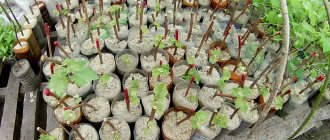Maiden grape, or parthenocissus (Parthenocissus), is a tree-like vine from the Grape family. In nature it can reach 30 m in length.
It is used as an ornamental plant to decorate fences, building walls, gazebos, unaesthetic buildings, and also as a ground cover crop.
It has many advantages, including:
- Ability to grow on any soil, low maintenance, frost resistance, long life span.
- Reaches 3 meters in two years.
- Resistant to pests and diseases.
- Development in both sunny areas and shade.
- The ability to form a crown of any shape, thanks to the plasticity of the vines.
- Ease of reproduction.
Varieties of virgin grapes
Three varieties of parthenocissus are more common than others: Virgin, Attached and Ivy-shaped.
The Virginia or Five-leaf grape vine can grow up to 20 m long. Its oblong, pointed leaves turn red in autumn. In July it blooms with white flowers, in place of which inedible dark blue berries are then formed.
The leaves of the Tripoint grape are similar to an ivy leaf, hence its name - ivy-shaped. This variety is widespread in Korea, China, and Japan.
The attached Maiden grape clings to the support with the help of tendrils. Its oval-shaped leaves, pointed at the end, consist of three or five leaflets. In autumn they take on a dark red hue.
Maiden grapes decorate the facades of private houses
Planting and rooting
The size of the planting hole should be 50 by 50 centimeters . The depth can be the same, but here it is necessary to take into account the size of the root system. The cuttings are dug in and watered with four buckets of water so that the plant takes root faster.
does not require support . The grapes grow well along the hedge. With the help of tendrils, vines can climb even on smooth surfaces.
But here it is necessary to remember that a sufficiently mature plant can fall to the ground from its own weight. And if you do not want to lose the picturesque carpet of greenery, then you should consider the option of installing supporting elements.
Material prepared in advance should be rooted . To do this, you can use one of the following methods:
- in water . The cutting will give roots easily, but in the ground they will still die off and be replaced by permanent ones. This option is good if there is still time before planting in the place allocated for cuttings;
- in the ground . This means planting cuttings in the place intended for them. It is desirable that it be separated from the rest of the area by a path or border, so that it is possible to water the area abundantly. At first the growth will be slow, then it will increase when the roots go fifty centimeters deep into the soil;
- in containers . The most practical option. The container should have a diameter of fifteen centimeters.
Rooted cuttings of wild grapes
Time of propagation and planting
There are no strict restrictions on planting time; wild grapes are tenacious and take root in almost 100% of cases. You can do this in spring, summer, and autumn, the main thing is to let the plant take root before frost. Seedlings grown in containers are planted at any time - from spring to September. Cuttings are carried out in spring and summer. In the July heat, rooted cuttings may not take root well, so it is necessary to provide them with sufficient watering.
Experts advise planting virgin grapes in September and until mid-October, so that the plant takes root and takes root before winter, and begins to grow actively in the summer. At this time, the conditions are the most favorable: cool weather, rain-moistened soil. Seedlings planted in autumn grow very quickly in spring.
Care
Caring for seedlings is quite simple. The following recommendations should be followed:
- Loosen and weed the soil regularly in spring and autumn.
- Cover the exposed roots with soil.
- Water 4-5 times a season; if it rains regularly, reduce the number of waterings.
- Fertilize twice: in spring and during active growing season. Fertilize with complex fertilizer.
- Pruning should be done regularly, removing dry branches, excess vines and bunches.
- If necessary, tie it up.
It is quite easy to grow virgin grapes on your plot. It will become a wonderful decorative element, and will also protect from dust, wind, sun, or decorate the walls of buildings. It is easy to care for and will look very impressive.
Selecting a location
Maiden grapes are usually planted, having previously installed supports, around gazebos, along fences, and garden paths. It is customary to use it to decorate facades.
When choosing a location, there are a number of factors to consider:
- An aggressive and rapidly developing root system negatively affects neighboring crops.
- Powerful roots can damage the foundation of a country house.
- The ability of vines to grow under the roof and disrupt its integrity.
- Fallen leaves can clog gutters.
Wild grapes are propagated by cuttings, seeds, root suckers, and layering.
Best time to breed
And if the temperature regime turns out to be favorable, the seedling will begin to develop early. And you won’t have to look for a place to store cuttings, which is also important. The best time for planting is September - October .
The best time to plant seedlings in the ground is September-October
The “green hedge” will serve you for decades, producing enough foliage to cover large areas. One vine grows up to four meters in length per year. This means that the formation of bushes should be started immediately so as not to neglect the plant.
The grapes only need minimal support to begin to take over the space around them. All you have to do is make adjustments by pruning the bushes in a timely manner.
Cuttings in the spring
In the spring, as soon as the buds begin to wake up, cuttings are prepared from last year's woody shoot. The liana is cut into shanks, so that each has from two to four nodes. It’s good if small antennae are visible in them.
The prepared cuttings are placed in a container with water for several hours. Then they are planted in the selected area. Wild grapes prefer partial shade; when planted along a building, they retreat about 1 m from the foundation. When planting several plants, holes are made at a distance of about 0.8-1 m from each other.
Advice! It is recommended to plant cuttings directly into the ground. Rooting in water is a last resort if it is impossible to plant in the ground.
Landing occurs as follows:
- dig holes 15-20 cm deep;
- the distance between the holes is maintained at about 80-100 cm;
- fill up the drainage (crushed stone, pebbles, broken brick);
- seedlings are placed in the holes at a slight angle;
- sprinkled with earth.
During the first two years, wild grapes are weeded and watered until the plant gets stronger.
Cuttings are a common method of propagating grapes.
Care after landing
Maiden grapes are an unpretentious crop that even an inexperienced gardener can grow with minimal care.
Necessary conditions for cultivation
The vine will require special attention during the period of active growth. Young plants need support in the form of a trellis with several levels of garter. Given the rapid growth and number of shoots, it is advisable to use a special tool for gartering - a tapener.
Tapener for gartering wild grapes
The device reduces the time of the procedure and does not damage the shoots. Loosening to saturate the roots with oxygen and weeding to remove weeds are mandatory.
What to feed and how to water?
With normal precipitation, the vine is watered 3-4 times per season. A 10-liter bucket of water is poured under the root of each bush. Simultaneously with watering, fertilizing is carried out; the Kemira mineral complex series is suitable for this. For the first time in the spring, Kemira Combi is used, which balances the microelements necessary for growth and development.
It is recommended to fertilize with liquid solutions (40 g of substance per 40 liters of water). The second feeding is carried out during the formation of flower ovaries with the preparation “Kemira Lux” (20 g/10 l). During the fruiting period, the plant needs potassium (20 g of potassium sulfate is dissolved in 10 liters of water). In the autumn, after harvesting, the plants are sprayed with potassium magnesia 15 g/10 l per leaf.
Timing and features of pruning
The question of whether it is necessary to prune the vine, given the rate of development of the green mass, becomes irrelevant. Without this procedure, cultural planting of an ornamental plant will turn into a thicket.
- In the spring , before the sap begins to flow, you need to remove branches that could not withstand frost, broken with signs of damage. Inspect the bush for the presence of shoots that do not want to grow in the direction of the support; they are also removed.
- In summer , newly formed stepsons that thicken the crown are removed. Remove shoots whose tops have changed direction of growth.
- In autumn - prepare for shelter for the winter. Remove wind-damaged and dried branches.
Video: Autumn pruning of wild grapes
Transfer
If there is a desire or need to transplant an overgrown bush to a new location, the procedure is carried out in late spring or summer. The selected area is dug up with a spade and compost is added (0.5 buckets per 1 m²).
You need to replant according to this scheme:
- Dig a hole 60x60 cm, place 15–20 cm of broken brick at the bottom, and sprinkle with a mound of soil.
- A bush is placed on a hill of earth, the roots are straightened so that they do not bend, and the plant is sprinkled with soil.
- The root collar of the bush should remain above the surface.
- Afterwards the bush is watered abundantly.
Cuttings in summer
In summer, parthenocissus is propagated by green cuttings. To propagate virgin grapes, in June cuttings are cut from new young shoots, taking a small piece of the old vine.
If necessary, trellises are installed at the site of the intended planting. Then they dig holes about 20 cm deep, the cuttings are placed there at an angle, the lignified part should be completely in the ground, sprinkled with earth, compacted a little and watered.
When growing wild grapes in summer, it is especially important to monitor soil moisture; the soil under the plant should not be allowed to dry out. In spring, during watering, young plants are fed with a solution of nitroammophosphate and mulched with humus or peat.
When the grapes grow, they will need formative pruning, otherwise the vines can entangle everything nearby and the beautiful ornamental plant will become a weed.
Rules for preparing cuttings
Having decided to plant cuttings in the fall, they should be prepared in spring or summer , using twigs with clearly visible leaves. You can prepare planting material from single-color shoots - they will be the healthiest.
Thick cuttings are not suitable for planting. Having cut off a suitable branch, it should be cleared of whiskers and stepson processes. The cuts are made a couple of centimeters below the sheet.
The optimal length of the cutting is from twenty to thirty centimeters ; it should have at least four formed buds.
By layering
Under the selected green shoot, dig a groove about 5 cm deep, add a little peat or compost, and ensure that the soil is loose enough. The vine is placed there without changing its shape or stretching, it is secured with pins and lightly sprinkled with earth and watered. The following summer, the cuttings are separated from the mother bush and planted in a permanent place of growth.
Maiden grapes can be propagated by layering
Propagation by layering is a simple and popular method, widespread among gardeners.
Pros and cons of propagating virgin grapes by cuttings
The advantages of this propagation method include the following:
- easy preparation of planting material with your own hands;
- the possibility of acquiring it;
- rapid rooting of seedlings;
- active growth of green mass;
- Planting cuttings can be done at any time, before the onset of late autumn.
As a disadvantage, we can point out the need to provide shelter for cuttings in hot weather and regular watering.
Seeds
This is a less common method of propagating wild grapes. To obtain the seeds, ripe parthenocissus berries are harvested around mid-September.
The fruits are kept at home at room temperature for about two weeks, then the berries are cut and the seeds are removed. They are washed, dried, and packaged in paper bags. Thus, the seeds are stored until spring at a temperature of about 23°C and moderate humidity.
Important! The fruits of virgin grapes are inedible. The berries contain large amounts of oxalic acid and can cause poisoning.
1-2 months before planting, the seeds are subjected to stratification (hardening) as follows:
- wet sand is poured into a box or plastic container (instead of sand, you can use cotton pads moistened with water);
- grape seeds are placed in the prepared substrate;
- send a box of seeds to the cold, this could be a balcony, terrace, or the bottom shelf of the refrigerator.
About two days before you want to plant the seeds in open ground, they are taken out of the refrigerator and soaked in a saucer of water at room temperature.
Preparing the bed
It is better to grow girlish grapes on the sunny side of the building. If the plant does not have enough light, then in the fall the leaves will not acquire a beautiful purple hue, but will remain green, and the parthenocissus will look less decorative.
Another piece of advice for those growing maiden grapes: do not plant them near fruit trees; the vine, wrapping itself around the trunks and branches, can harm them, or even “strangle” them. The best place for planting is around arbors or along garden paths equipped with trellises.
The process of planting seeds in open ground
- In the selected area, dig a ditch 60 cm deep.
- Drainage made of pebbles, crushed stone or expanded clay is laid at the bottom.
- A mixture of soil, humus and sand is placed on top in a ratio of 2:2:1.
- The soil is loosened and leveled.
- Holes are made in the soil about 1 cm deep at a distance of half a meter from one another.
- Place one seed in each hole and lightly cover it with earth.
- Water carefully, preventing the seeds from being washed out of the soil.
When the shoots appear and the stems begin to grow, the grapes can be fed with organic matter or a green mass growth stimulator.
If it is not possible to obtain seeds directly from the berries, you can buy ready-made ones in the store.
Parthenocissus berries are not edible
Recommendations for care and reproduction
There are several methods for propagating virgin grapes:
- green layering;
- cuttings;
- seeds;
- root suckers.
Maiden grapes begin active growth in early summer. It is optimal to propagate it in spring, summer and autumn.
It is recommended to prepare compost dug soil: leaf soil, compost and sand (2:2:1). At the bottom, drainage is made of pebbles or crushed bricks. 7 days before planting the seedling, the soil is loosened.
The liana is not whimsical towards the cardinal direction: in the illuminated southern areas the color of the foliage will be red, and in the darkened areas it will be green.
No additional care required. It grows on its own, adapting to weather conditions. The liana requires pruning if it falls under its own weight or its growth does not suit the owner.
Place a vertical support so that it curls over it.
Rooting
The best way is to root in the soil, which should be fertile and loose. In it, cuttings and offspring quickly take root.
The stem must be buried at an angle or in a semi-recumbent state, which increases the volume of the roots. At least two buds are left above the ground surface. For the first one or two weeks, it is important to water regularly so that the process of formation of the root system is active.
It is recommended to immediately build a support. The seedling should take root and produce its first shoots after one month.
If it is not possible to immediately root into the ground, you can do this in cups.
Propagation by cuttings
The plant lends itself well to propagation by cuttings
Cuttings are less sensitive to weather conditions. The technology for preparing kidneys differs depending on the time of year. To begin with, a branch with dormant buds is cut from the vine. It is cut into sections that should have 2-4 nodes. In summer, branches with woody shoots are cut off.
Further options:
- Root directly into the ground. In this case, the sprouts need care: weeding, watering until they take root and get stronger.
- Root in water. This type is suitable if it is not possible to immediately plant the material. The shoot will stand in the water and grow roots, but they will not be viable in the soil. This time is a buffer zone that will keep the cutting alive.
- Plant in containers. This method is suitable for material taken in early spring or that will be planted the following year. The cuttings are planted in pots with oxidized peat soil and cared for like seedlings.
Pots can also be stored outside, leaving them to overwinter under film or leaves. It is recommended to plant in open ground from April to early autumn.
Choosing a place
When choosing a place to plant virgin grapes, you need to take into account some conditions:
- It should not be planted near drainage holes or drainage holes; heavy autumn leaf fall can completely block the outflow of water.
- Those who dream of decorating a wall with a vine should know that the plaster may not support the weight of the branches, and there is a risk that it will collapse over time.
- The optimal place is the design of buildings or fences. Walls made of wood under thick foliage do not deteriorate; concrete and brick surfaces feel good under it.
- You need to make sure that the branches do not spread across the roof; slate is not always able to withstand such a load.
- Grapes love the sun's rays; they are usually planted in illuminated areas; if such conditions cannot be created for them, they will feel good in the shade. But the color of the leaves will be affected by a decrease in the level of illumination; we cannot wait for the autumn riot of colors; the foliage will remain green until frost. On the sunny side the leaves will be larger and the bush will develop better.
- Lianas do not like cold winds and drafts; they will grow poorly and may wither, so you need to choose protected areas.
The plant can also be planted on loggias and balconies, but it needs to be watered there more often.
At first, the bush will grow green mass slowly; it spends energy on the development of roots; during this period, high-quality care is important.
Grapes grow most beautifully on the sunny side
Maiden grapes as a garden guest: growth rates, planting, reproduction
Maiden grape is a deciduous tree-type vine from the Grape family. It is also known as virgin ivy due to its ability to self-pollinate. The growing area extends from Asian countries to the shores of North America. There are about 12 varieties of this plant in the wild. Winter-hardy varieties are widely used in landscape design.
If virgin grapes are chosen for the garden, planting and caring for them will not take much time. Due to their unpretentiousness and high frost resistance, wild grapes are actively used to decorate outbuildings, covered benches, gazebos, arches, columns, and plant sculptures. It goes well with different varieties of spirea, weigela, and forsythia. This plant's buds bloom on last and new year's shoots, forming a lush crown in early spring.
Planting methods
The crop is planted in several ways; each gardener chooses the most applicable option for himself:
Cuttings
The method for propagation is the most successful, the cuttings take root quickly, and after winter they begin to actively develop. Seedlings for planting can be taken from neighbors or cut yourself, to plant in the soil, it is prepared:
- for this, in the summer, a long, woody shoot is selected, divided into several parts about 30 cm long, with 4 mature buds;
- they are placed in a bowl with water until the roots appear;
- the water should cover 2 buds, a root system will form on them, and the bush itself will develop from the upper buds;
- when the roots appear, the shoots can be planted in the ground;
- after planting, the cuttings are thoroughly moistened and covered with light material so that the sun’s rays do not dry it out;
- it is necessary to constantly moisten the soil.
In the spring, the rooted seedling will quickly grow.
Cuttings with roots can already be planted in the ground
By shoots
The method is quite productive and almost 100% leads to a positive result. Its convenience lies in the fact that it allows the process to be carried out when the owner is not able to be on the garden plot every day:
- make a hole in the ground no more than 5 cm, water well;
- select two or three-year-old branches from the bush, bend them to the ground and secure them in this position with strong wire;
- the place where the vine comes into contact with the soil is covered with earth;
- you need to ensure that the soil remains moist at all times;
- roots will soon appear in this place;
- in the fall, the branch is cut off from the main bush, divided into cuttings, each one is carefully dug up and transplanted to a permanent place.
There is another equally successful option for planting by layering. To do this, cut off a long shoot, somewhere from one and a half meters, you can take a three-meter vine, also make a depression and fill it with water.
The branch is planted in the ground in a wave-like manner, like a sinusoid: the parts where the buds are located are deepened into the ground and pinched with a pin, the remaining segments remain above the surface. In this case, branchy young shoots appear. The cuttings are divided into cuttings and planted.
Cuttings with roots are cut off from the main branch and planted in new places
Read also: Favorable days for replanting orchids
Seeds
Growing virgin grapes from seeds is not a popular propagation method; this process is labor-intensive, and seed germination takes a long time. But you shouldn’t completely exclude it; it has a right to exist, it is irreplaceable when it is impossible to obtain a shoot of the desired variety.
Seeds are harvested at the end of summer, selected from ripe berries; they remain viable for no more than a year. Seeds take a very long time to germinate, at least a month; for spring planting they must be stratified. In the fall, they are simply placed in prepared soil, in holes 1 cm deep. Shoots will appear next spring, over the summer they will get stronger and turn into a small bush.
When planting virgin grapes in a permanent place, the distance should be maintained at least 100 cm.
Planting virgin grapes with seeds is a long and troublesome task.
Planting purchased seedlings
When choosing a place for placement, you need to take into account that a mesmerizing bright red-crimson carpet will appear by autumn if the south side is chosen for planting. On the western or eastern wall it will begin to develop quickly and the foliage will be large.
- The decorative liana is not demanding on soil fertility. To achieve the desired bushiness, it is recommended when planting to prepare a substrate from peat, leaf soil, and compost, taken in equal proportions. If the soil is heavy, add a little sand.
- A couple of days before planting, a 20 cm high drainage of broken brick or crushed stone is poured into the bottom of the planting hole. Then the substrate is added up to half of the hole.
- It is recommended to plant mature seedlings in early spring or autumn at a distance of 50-70 cm. They are placed in the center of the planting hole and sprinkled with substrate. The root collar should remain on the surface, but not rise above it.
- It is advisable to mulch the tree trunk circle with peat, bark, and dry grass. The layer thickness should be 5-8 cm. Mulch will protect the soil from rapid evaporation of moisture and help eliminate seasonal weeding.
Video about growing rules.
In the future, the seedlings will need watering once a week until they take root. Adult plants need 3-4 moistenings per season during drought. Fertilizers begin to be applied from the 2nd year of growth, limited to 2 feedings per season. In May, 40-50 g of nitroammophoska are added under each vine, in June - 200 g of Kemira Universal.
Containing growth and pruning girl grapes, preparing for winter
The notorious aggressiveness that is attributed to the liana manifests itself when they do not care at all about basic control over the development of the plant. False grapes will never crawl over a fence or climb onto a roof if they are pruned in time.
Maiden grapes only need controlled pruning.
If he begins to move to another territory, the excess lashes are cut off. The more often you cut them, the thicker the crown will be. To curb growth, most gardeners keep watering and fertilizing to a minimum. Dry branches should be periodically cut out, and exposed roots should be covered with soil.
In the first year after planting, the tree trunk circle is covered with spruce branches and dry leaves. Subsequently, the plants do not require shelter.
Patience is the key to success
Whatever vegetative method you use, remember that virgin grapes will build up the root system in the first 2, and most often 3, years and only then will their active growth begin in the above-ground part. This is a unique plant, in which the roots must first reach a meter deep and be fully formed for the shoots to actively grow in length.
And during this entire period, you should not forget about the virgin grapes: it will benefit from watering during drought, and at least one fertilizing with complete mineral fertilizers per year, and mulching to prevent overheating of the roots. But the main thing is not to forget to fight the weeds around the plant, not allowing them to “choke” your vine, which will become a giant only after a few years.
Caring for a young plant
Care does not require special measures, just the usual actions: timely watering and removal of excess vines. But if you want the grapes to please you with their splendor and well-groomed appearance, in order to create the most camphoric conditions for them, you will have to make more efforts and take more careful care:
- at first it is necessary to correctly form the bush, the main shoots are cut out with pruning shears a meter from the ground, the side branches are directed in the desired direction and tied until the bark is formed;
- in summer, care includes constant destruction of weeds;
- the roots are sometimes exposed, so they are periodically covered with earth;
- the tree trunk circle needs to be mulched with peat or humus; in the fall the ground is dug up, deepening the covering;
- in early spring, when the bush has not yet woken up, frozen and dry branches and damaged shoots are cut off, and those that spoil the aesthetic appearance are removed;
- The branches of the vine grow very quickly, so it is undesirable to skip pruning; if you do not include it in the care, the branches will intertwine, oppress each other, the leaves will be crushed and the bush will lose its beauty, in this case, to give the plant a decent appearance, you will need to remove all the branches.
Watering is carried out moderately as needed, 10 liters per bush is enough, if the summer is hot, the multiplicity is increased.
In June, an adult shrub needs to be fed; nitroammophosphate can be used; during the period of increasing leaf mass, fertilizers with a wider range of components are suitable.
If everything is done correctly and subsequent care is provided, soon the site will be adorned with a lush climbing shrub of maiden grapes, pleasing to the eye. By the way, for the winter, adult shoots do not need to be insulated, but young branches or shoots are wrapped with covering material.
How to plant virgin grapes: planting and caring for wild grapes at the dacha. Maiden grapes are an excellent find for summer residents who want to see a green fence instead of a fence, and instead of ugly walls of old buildings, shoots crawling along them.
A climbing plant with beautiful carved leaves that does not require complex care and can cover a significant surface in a relatively short time is the dream of many gardeners. And exactly such a plant is wild or virgin grapes, planting and caring for which is not particularly difficult.
What are girlish grapes?
This plant belongs to the genus Parthenocissus, and most species are native to East Asia and North America. Three types are traditionally grown as ornamental plants: tripointed or ivy grapes, attached grapes, and five-leafed or Virginia grapes, which are best adapted to grow in our climate.
The wild grape itself is a root-climbing vine. The plant tolerates shade and sub-zero temperatures well. Not demanding on soil and easy to care for. It grows quickly and can grow up to 2-3 m in a year. Throughout the entire life cycle, individual lashes reach about 20 m in length.
Of particular decorative value are the large carved ornamental leaves, which in the fall acquire a dark crimson color. The plant blooms rather modestly, but the flowers emit a pleasant aroma, attracting bees. The fruits of ornamental grapes are inedible. They ripen in September, acquiring a dark blue hue with a smoky waxy coating.
The plant will be a real boon for those who need to quickly decorate a fence or ugly walls of outbuildings. But how to plant wild grapes in a country house or garden plot?
Read also: Moonshine tincture with cherry chips recipe
How to plant wild grapes
To plant girlish grapes correctly, you do not need to have any special skills. It is enough to follow a few simple rules.
1. When to plant wild grapes?
The timing of planting wild grapes is often determined by the weather and climatic conditions of the region and the chosen method of propagation. According to experts, ornamental grape seedlings take root well both when planted in spring in April and May, and when planted in the ground in autumn in September - early October. True, if you plant girlish grapes in the fall, the young plants will need shelter for the winter.
You can also grow parthenocissus from seeds, but in this case they are sown in pots in January-February. But it is better to plant cuttings of wild grapes in the soil in May-June. Regardless of whether virgin grapes are planted in spring, summer or autumn, experienced gardeners advise carrying out such manipulations before 11 a.m. in the morning or after 6 p.m., which will help protect the plants from burning out.
2. Choosing a landing site.
Before planting girlish grapes, you need to choose the right place where the plant will be as comfortable as possible. Parthenocissus is not particularly picky about soil composition, and is capable of developing quite normally in both well-lit and shaded areas of the garden. At the same time, wild grapes grow best in fertile, moisture-permeable soils and well-lit areas. The only thing you should remember when planting is that the plants require reliable support, for which a simple stretched wire will not work. In addition, virgin grapes planted on the north side may have smaller leaves, and in the fall the foliage on plants with this arrangement remains dark green, while specimens growing on the south side gradually turn purplish-red.
3. Site preparation.
About a week before planting girlish grapes, you need to dig up the area and prepare the soil. For seedlings, dig holes measuring about 50x50x50 cm (depending on the root system, the size may vary). A 20-centimeter layer of drainage is placed at the bottom of the hole, for which a mixture of small pebbles and sand, broken brick or crushed stone is suitable. The remaining volume of the hole is filled with a soil mixture consisting of peat compost, leaf soil and sand in a ratio of 2:2:1; you can also add wood ash (about 1 liter of a jar). If the soil is properly amended before planting, the plants will have enough fertilizer for the next 3-4 years.
4. Technology of planting girlish grapes.
When the holes with drainage and soil mixture are ready, you can proceed directly to planting. So, let's figure out step by step how to plant girlish grapes.
The hole with drainage is half filled with soil mixture. Place the seedling in the hole at a slight slope and cover it with the remaining soil so that the root collar does not rise above the soil surface. A watering hole is formed near the seedling. For the first watering, plants use at least 1 bucket of water.
When talking about how to plant wild grapes, it is necessary to clarify at what distance the cuttings should be planted from each other. It is often recommended to leave gaps of at least 50 cm between individual plants. Although, taking into account the fact that ornamental grapes grow at a high speed, the optimal distance reaches about 1 m.
5. Primary care of wild grape seedlings.
It is worth noting that ornamental grapes are an unpretentious plant. For its normal growth, it is enough to loosen the soil from time to time and remove weeds. The plant does not require frequent watering. It is enough to water it 3-4 times per season at the rate of 8-10 liters of water per plant. In hot weather, the watering rate can increase to 20 liters. To prevent the soil from drying out and weeds from growing, the soil around the shoots is covered with a 6-centimeter layer of mulch (straw, sawdust, peat).
In the early stages of the growth of virgin grapes, special attention must be paid to the formation of shoots. Since the plant is climbing, it requires stable support. Of course, if you plant wild grapes along a fence or near the walls of a building, then you won’t have to work especially hard to build a support - the tenacious tendrils of the vine will easily grab onto even the slightest roughness. Support may be required if at first the plants have nothing to grab onto. In addition, so that fast-growing shoots do not create problems, they must be guided as they grow, fixing the stems on a support. Excess unruly lashes and wilted leaves must be removed in time. It is also important to ensure that the vines do not spread along the surface of the ground, since they quickly take root and send out new shoots, which can quickly turn the entire area into an impenetrable thicket, and it is quite difficult to get rid of wild grapes creeping along the ground.
Transplanting girlish grapes
Sometimes it becomes necessary to transplant wild grapes to another place or replant the plant. It is worth noting that it is advisable to do this in early spring or autumn, when the active growth of plant shoots is suspended. Replanting virgin grapes in the summer will be somewhat more difficult, but with a small bush, such manipulation is possible.
The preparation and technology for transplanting ornamental grapes is almost the same as for planting a plant. The main thing is to prepare the soil for planting in time. The depth of the hole is determined by the size of the seedling's root system. When replanting, the roots can be shortened somewhat, especially for damaged roots. The soil is filled with peat compost, wood ash or mineral fertilizers. In summer, transplanted plants require more frequent watering until they are completely rooted.
Advantages and disadvantages of wild grapes
Maiden grapes, planting and caring for which do not require much effort, are a plant that some gardeners consider an excellent option for quickly greening up a plot, while others are wary of its ability to cling to almost any surface and its rapid growth, since if neglected this can have and negative consequences.
Read also: Red Knight pepper characteristics and description of the variety
Pros of virgin grapes:
• shoots develop quickly, fill the entire support, forming a dense curtain;
• undemanding to soil and lighting;
• resistant to pests and diseases;
• does not require frequent fertilization;
• dense foliage protects the walls and foundation of the building covered with wild grapes from overheating, rain, wind and dust, as well as excessive dampness;
• has an attractive appearance from early summer to mid-autumn.
Disadvantages of virgin grapes:
• uncontrollably growing strong shoots that fall under slates or tiles can destroy them;
• shoots growing near drains can get inside the tubes and clog them;
• hanging over the windows, the vines form a real curtain, not allowing light into the room;
• planted near plastered walls, wild grapes can cause damage to the plaster over time: the vine gradually grows into the surface and under its weight the finish can simply fall off;
• a strong root system, extending several meters underground, can harm plants planted in the neighborhood;
• in spring, wild grapes develop later than other garden plants, presenting an unsightly picture of tangled, bare stems.
When talking about planting wild grapes in a specific area, it is important to consider its positive and negative aspects. But with its ease of planting and growing, as well as the high decorativeness characteristic of this plant, with little care it can become a real decoration of your site. published econet.ru
Did you like the article? Then support us, click
:
Maiden grapes (also sometimes called wild grapes) are perhaps the most unpretentious of all ornamental plants used by gardeners to decorate their plots. It is completely undemanding to either the landing site or the type of soil. Propagation is very easy, including cuttings. It grows quickly and does not require any care other than watering in dry weather.











